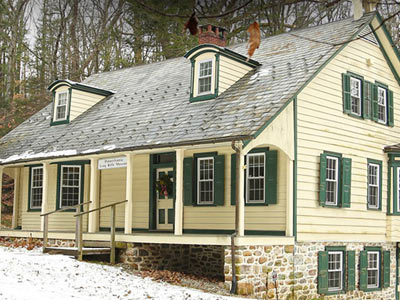No guide to America’s gun collections would be complete without inclusion of a museum dedicated to the Pennsylvania longrifle, which figured so large in America’s fur trade and military exploits of the early nineteenth century. In most Pennsylvanian museums, both large in small, there is sure to be a case or two of longrifles. The Pennsylvania Longrifle Museum stands out, as it is the site of one of the key manufacturing locations of the five-generation Henry dynasty of gun makers, who built 100,000 rifles over one hundred years. This family of gun makers is not to be confused with New Hampshire native Benjamin Tyler Henry who developed the lever action 1866 Henry rifle. Situated in a bucolic landscape, The Pennsylvania Longrifle Museum is located in the historic Joseph Henry 1832 Homestead that opened to the public in 2006. Almost all of the hundred guns in the collection were handmade by successive generations of the Henry family, starting with Abraham Henry (1768-1807). It is a unique collection, in that it focuses on guns made by one extended family. The museum exhibits longrifles, accoutrements and the tools used in the context of their construction. Henry rifles in .45 cal. were sold to the American Fur Company and large military contracts for .70 cal. muskets were obtained for the War of 1812. Henry longrifles were still being used by sharpshooters in the American Civil War, although no contracts were secured. The company went into slow decline with the advent of mass-production guns made with machine tools in large factories, and he last hand-crafted Henry longrifle was sold in 1912. http://americanlongrifles.org/forum/index.php?topic=22490.0
Jacobsburg Historical Society
http://www.metmuseum.org/about-the-museum/museum-departments/curatorial-departments/arms-and-armor
http://www.jacobsburghistory.com/society-collections/pennsylvania-longrifle-museum/


 1. West Point Museum
1. West Point Museum 2. Springfield Armory
2. Springfield Armory 3. Smithsonian Museum
3. Smithsonian Museum 4. Nunnemacher Milwaukee
4. Nunnemacher Milwaukee 5. Wadsworth Atheneum
5. Wadsworth Atheneum 6. Rock Island Arsenal
6. Rock Island Arsenal 7. Metropolitan Museum NY
7. Metropolitan Museum NY 8. National World War I
8. National World War I 9. FBI Reference Collection
9. FBI Reference Collection 10. NRA National Firearms
10. NRA National Firearms 11. Connecticut History
11. Connecticut History 12. Remington Firearms
12. Remington Firearms 13. Davis Arms Museum
13. Davis Arms Museum 14. National Cowboy Mus.
14. National Cowboy Mus. 15. American Precision
15. American Precision 16. Collectors Firearms
16. Collectors Firearms 17. KY Military History
17. KY Military History 18. Cody Firearms Museum
18. Cody Firearms Museum 19. Woolaroc Museum
19. Woolaroc Museum 20. Kienbusch Philadelphia
20. Kienbusch Philadelphia 21. John Browning Museum
21. John Browning Museum 22. Art Institute Chicago
22. Art Institute Chicago 23. Henry Stewart VMI
23. Henry Stewart VMI 24. Autry Museum
24. Autry Museum 25. Wood Museum S&W
25. Wood Museum S&W 26. National WWII Museum
26. National WWII Museum 27. Frazier History Museum
27. Frazier History Museum 28. Pennsylvania Longrifle
28. Pennsylvania Longrifle 29. Frank Brownell Museum
29. Frank Brownell Museum 30. Inst. Mil. Technology
30. Inst. Mil. Technology 31. NRA Bass Pro Sporting
31. NRA Bass Pro Sporting 32. U S Army Museum
32. U S Army Museum